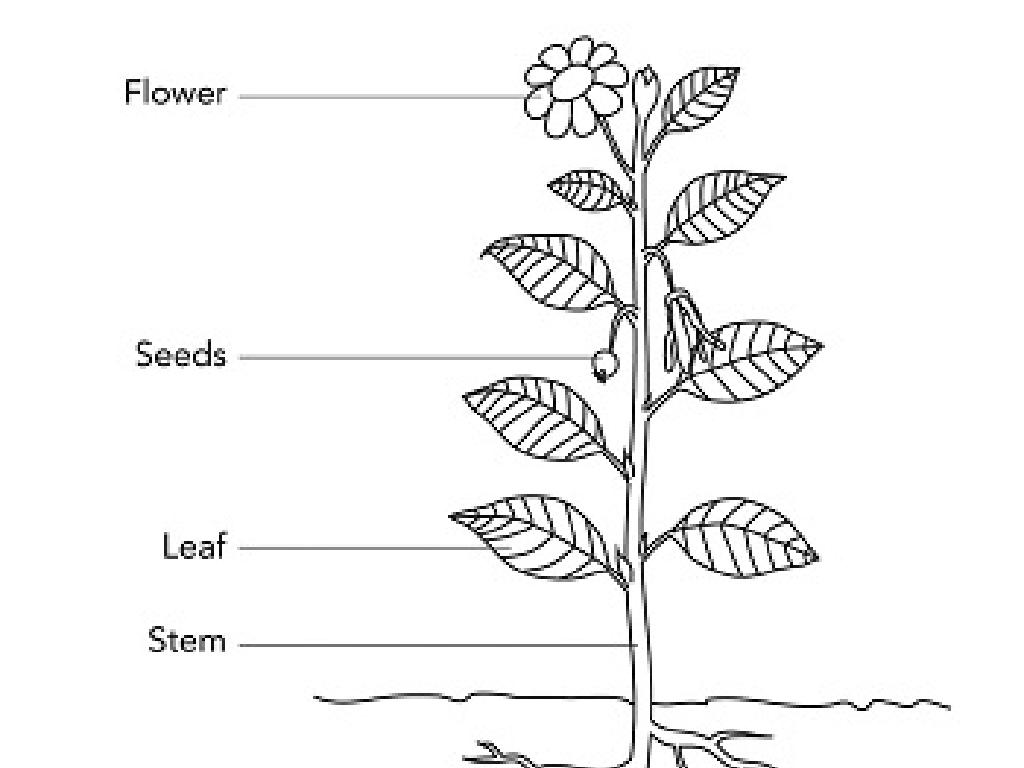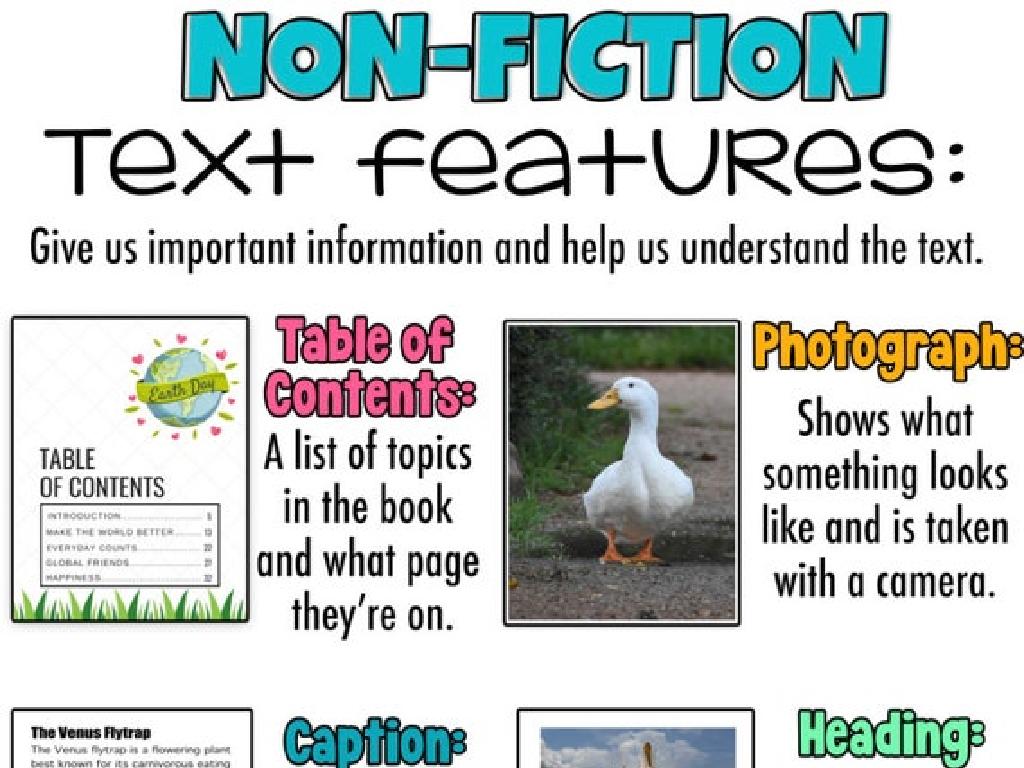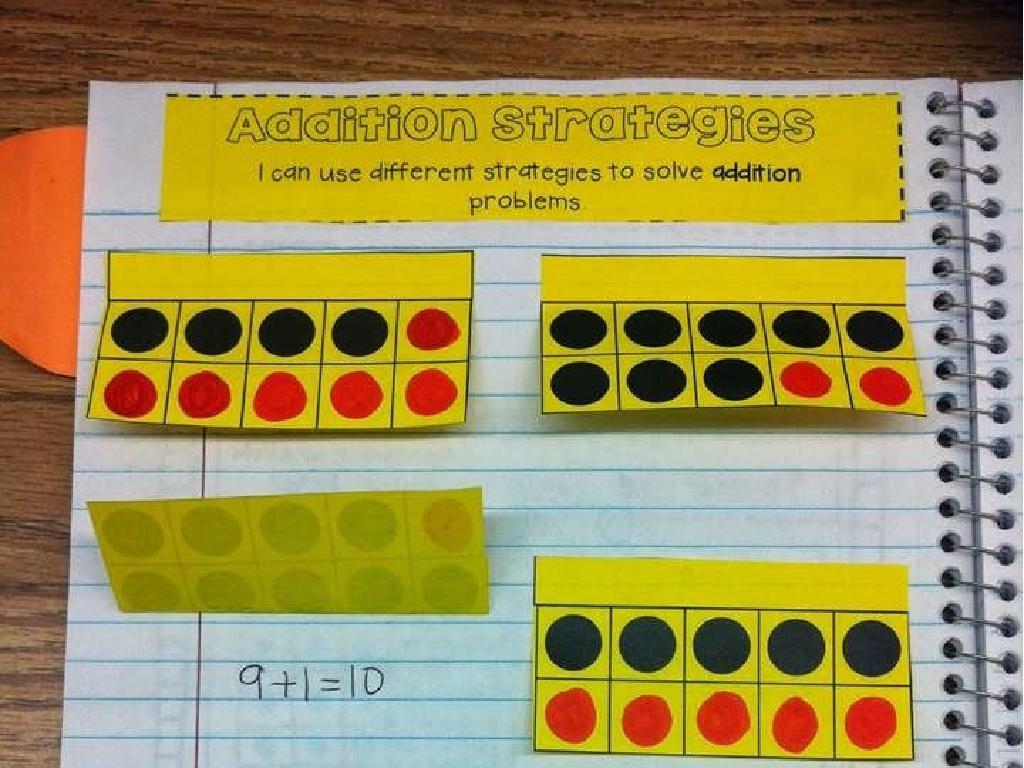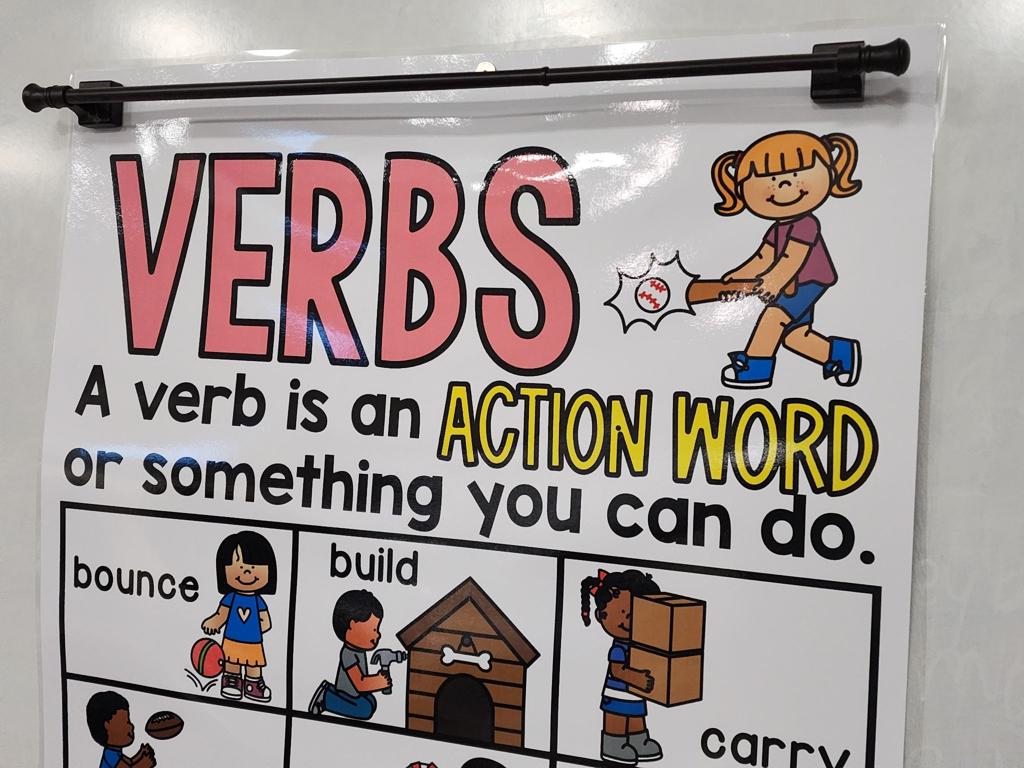Read About Science And Nature
Subject: Language arts
Grade: Fifth grade
Topic: Informational Texts: Level 2
Please LOG IN to download the presentation. Access is available to registered users only.
View More Content
Exploring Science & Nature in Reading
– What are Informational Texts?
– Nonfiction texts that provide facts about the world.
– The thrill of science and nature
– Discovering how things work and the wonders of the natural world.
– Benefits of reading informational texts
– Gain knowledge, improve reading skills, and develop new interests.
– Encouraging curiosity and learning
– Reading about real-world topics sparks questions and exploration.
|
This slide introduces students to the concept of informational texts, focusing on the topics of science and nature. Informational texts are nonfiction and provide factual information about the world around us. Emphasize the excitement of uncovering the mysteries of science and the beauty of nature through reading. Discuss the benefits, such as gaining knowledge, improving reading comprehension, and finding new areas of interest. Encourage students to think of reading as an adventure, where every book allows them to explore and learn about something new. Ask them to consider questions they have about the world and how reading might help answer them.
Exploring Informational Texts in Science and Nature
– Define Informational Text
– Texts that inform, explain, or teach about a topic.
– Fiction vs. Non-Fiction
– Fiction is made-up stories; non-fiction is based on facts.
– Examples in Science & Nature
– Weather articles, animal books, plant guides.
– Understanding Text Features
– Look for headings, glossaries, and indexes to help understand.
|
This slide introduces students to the concept of informational texts, focusing on the domain of science and nature. Begin by defining informational text as a genre that provides factual information about the world around us. Highlight the key differences between fictional stories and non-fictional texts, emphasizing that informational texts are based on facts and real events. Provide examples relevant to science and nature, such as articles about weather phenomena, books about different animal species, or guides to various plants. Teach students to recognize and utilize text features like headings, glossaries, and indexes to better comprehend and navigate informational texts. Encourage them to explore these texts with curiosity and to use the features to find interesting facts about science and nature.
Exploring Features of Informational Texts
– Table of Contents, Index, Glossary
– They help you navigate and find information quickly in a book.
– Importance of Headings & Subheadings
– They organize the text and hint at what the section is about.
– Understanding Captions, Diagrams, Photos
– Captions explain images, diagrams show processes, photos visualize facts.
– How these features help comprehension
– Using these features makes reading more engaging and educational.
|
This slide introduces students to the key features of informational texts that help with understanding and navigation. The Table of Contents provides an overview of the book’s structure, while the Index helps locate specific information. The Glossary defines key terms. Headings and Subheadings organize content and prepare the reader for what they are about to learn. Captions, Diagrams, and Photographs support the text and provide visual explanations. Emphasize how these elements enhance comprehension and make reading more interactive. Encourage students to use these features when they read about science and nature to improve their learning experience.
Mastering Informational Texts: Science and Nature
– Skim and scan for key info
– Quickly read titles, headings, and summaries to get an idea of the main topics.
– Make annotations and notes
– Write down important points, underline or highlight key words to remember them better.
– Ask questions while reading
– Be curious! Who, what, when, where, why, and how can guide your understanding.
– Understand and retain content
|
This slide aims to equip students with strategies to effectively read and comprehend informational texts about science and nature. Skimming and scanning are essential skills for identifying important information without reading every word. Annotations and note-taking are crucial for retention and reference. Encouraging students to actively ask questions turns reading into an interactive process, enhancing learning. These skills will help students not only in understanding the material but also in preparing for discussions and exams. Provide examples of each strategy and consider a class activity where students practice these skills with a short text.
Exploring Science Through Reading
– Grasp scientific vocabulary
– Learn terms like ‘habitat’, ‘species’, ‘ecosystem’
– Find main ideas in passages
– What’s the passage mainly about? Look for clues!
– Connect text to real-world science
– How does the text relate to what you see outside?
– Engage with science concepts
|
This slide aims to guide fifth-grade students in understanding how to read and comprehend science and nature texts. Start by introducing scientific vocabulary, ensuring students are familiar with key terms they will encounter in their readings. Teach them strategies to identify the main idea in science passages, such as looking for topic sentences and summarizing paragraphs. Encourage them to make connections between the text and real-world science concepts, drawing on their own experiences and observations. Engage them with discussions on how the information they read applies to the world around them, fostering a deeper interest and understanding of science in everyday life.
The Wonders of Nature: Exploring Through Reading
– Discovering ecosystems in texts
– Ecosystems are communities of living things interacting with their environment.
– Patterns in nature descriptions
– Look for repeated themes like life cycles or seasonal changes.
– Reading connects us with nature
– Stories and articles about nature deepen our understanding of the world.
– Reflect on nature’s interconnections
– Think about how everything in nature works together.
|
This slide aims to spark curiosity about the natural world by encouraging students to explore ecosystems through reading. Highlight the importance of recognizing patterns, such as the water cycle or animal migration, which are often described in texts about nature. Emphasize how reading can enhance our connection to the environment and foster a sense of stewardship. Encourage students to consider the intricate web of life and how all elements of an ecosystem depend on each other. Suggest reading materials that describe various ecosystems and ask students to share their thoughts on how these systems are portrayed in the texts they read.
Analyzing Informational Texts: Science and Nature
– Compare and contrast information
– Look for similarities and differences in texts about habitats or weather patterns.
– Evaluate the author’s purpose
– Is the author informing, persuading, or entertaining? Consider a text about conservation.
– Distinguish facts from opinions
– Facts are evidence-based, while opinions are beliefs. Identify these in an article about endangered species.
– Apply critical thinking skills
|
This slide aims to equip students with the skills to analyze informational texts on science and nature. Encourage them to actively compare and contrast information, such as different animal habitats or weather phenomena, to enhance comprehension. Discuss the author’s purpose and how it shapes the text, using examples like persuasive writing on conservation efforts. Teach them to differentiate between factual statements and opinionated claims, using real-world examples like articles on endangered species. Emphasize the importance of critical thinking when reading to understand and engage with the content fully. Provide exercises where students can practice these skills with various texts.
Class Activity: Create a Nature Journal
– Start your own Nature Journal
– Observe plants and animals
– Look closely at the nature around our school
– Write down your observations
– Note colors, sizes, behaviors, and any interactions
– Share findings with the class
|
This activity is designed to enhance students’ observation skills and appreciation for nature. Provide each student with a notebook or papers stapled together to serve as their Nature Journal. Instruct them to observe the natural environment around the school, focusing on plants and animals. They should take notes on specific details such as color, size, and behavior. Encourage them to think like scientists and record their findings accurately. After the observation period, have a class discussion where students can share interesting discoveries and reflect on the diversity of life they observed. Possible activities: 1) Sketching wildlife, 2) Comparing plant species, 3) Recording bird songs, 4) Investigating insect behavior, 5) Documenting weather changes.






